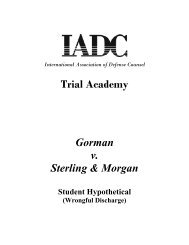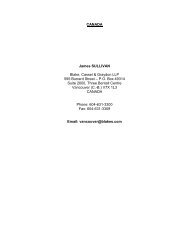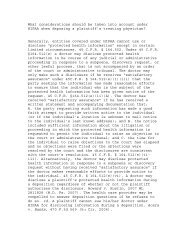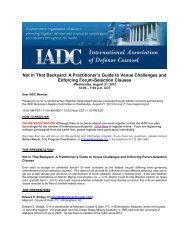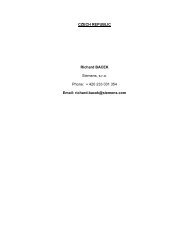Defense Counsel Journal - International Association of Defense ...
Defense Counsel Journal - International Association of Defense ...
Defense Counsel Journal - International Association of Defense ...
You also want an ePaper? Increase the reach of your titles
YUMPU automatically turns print PDFs into web optimized ePapers that Google loves.
Page 468 DEFENSE COUNSEL JOURNAL–October 2012replacement, but which is otherwisecomplete, will be treated as completed. 5A state-by-state review <strong>of</strong> thedecisions on this subject reveals a broadspectrum <strong>of</strong> interpretations spanning thegap from those which find that defectiveconstruction is never an “occurrence”(therefore, regardless <strong>of</strong> the extent <strong>of</strong>damage beyond the insured’s own workproduct, the claim is not covered), tothose which find not only that defectiveconstruction is an “occurrence” but thatthe business risk exclusions areambiguous and do not bar coverage forrepair and replacement <strong>of</strong> the insured’sown work product. Those positions definethe extremes, while the overwhelmingmajority <strong>of</strong> decisions within the twoextremes may be harmonized into adistinct set <strong>of</strong> broad principles.The true majority rule as toconstruction defects is that claims <strong>of</strong>defective construction, standing alone, donot meet the element <strong>of</strong> fortuity necessaryto constitute an accident and are thereforenot covered. However, where the work inquestion was performed by the insured’ssubcontractor, the damage is eitherconsidered “accidental from thestandpoint <strong>of</strong> the insured” or fits withinthe subcontractor exception to the “yourwork” exclusions. Similarly, to the extentthe insured’s defective work results indamage to other property not the subject<strong>of</strong> the insured’s work, that damage is alsogenerally covered. Leading decisions <strong>of</strong>each state are summarized in Appendix Ifollowing this article.A. Defective Construction isNever an “Occurrence”The Supreme Court <strong>of</strong> New Jerseyfirst recognized the requirement <strong>of</strong> afortuity analysis as a bedrock principle <strong>of</strong>insurance law in 1979 in what was andremains a landmark case, Weedo v. Stone-E-Brick. 6 Weedo involved a contractorwho installed stucco on the side <strong>of</strong> itscustomer’s house. The stucco latercracked and peeled. The homeownerssued the contractor, Stone-E-Brick, forthe cost <strong>of</strong> removing and replacing thedefective stucco. The New JerseySupreme Court was thus faced with thequestion <strong>of</strong> whether defectiveconstruction, standing alone, constitutesan “occurrence.” The court held that itdid not.The Weedo court distinguishedbetween the kinds <strong>of</strong> risks faced by atypical contractor, namely: 1) the risk thathis work will not meet the customer’sexpectation, thereby exposing him toliability in contract; and 2) the risk thatsome mistake on his part may result inbodily injury or property damage to athird party. In this regard, the courtnoted:While it may be true that thesame neglectful craftsmanshipcan be the cause <strong>of</strong> both abusiness expense <strong>of</strong> repair and aloss represented by damage topersons and property, the twoconsequences are vastly differentin relation to sharing the cost <strong>of</strong>5 Insurance Services Office, Form CG 00 0112 04.6 405 A.2d 788 (N.J. 1979).



